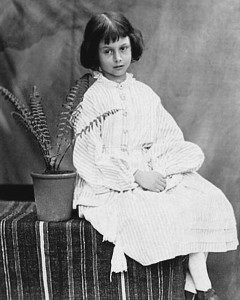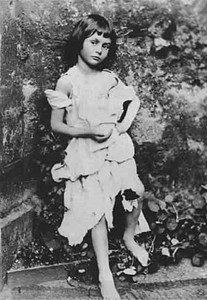Alice: Introduction
After their successful collaboration on "The Black Rider" (1990), Robert Wilson, Tom Waits and Paul Schmidt teamed up again for another play called "Alice". Waits was delighted to work with Wilson again, describing their relationship as that of "a blind crippled pigeon standing on the shoulders of a sighted giant"(4) The scenic concept had been worked out by Robert Wilson, Paul Schmidt and Wolfgang Wiens in August 1991.
During the first try-outs in February/ March 1992 Paul Schmidt added the texts adapted from "Alice in Wonderland" and "Through the Looking Glass" (the author of both books is Lewis Carroll, a pseudonym for Charles Lutwidge Dodgson). During the second try-outs in November/ December 1992 the songs of Tom Waits (and Kathleen Waits-Brennan) were added and some changes were made to the texts.
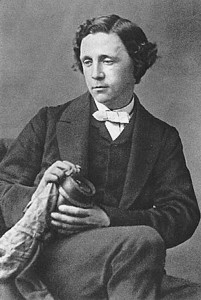
Charles L. Dodgson
Robert Wilson: (1992/ 1993): "I don't know, we're very different men, different lifestyles, different esthetics, we dress differently. Even our ideas about art are quit different. I'm a little more formal and cooler and he's a little freer. But somehow it works together. I think that our work's, that our work is stronger together then it is separate. Because we are different, we are counterpoints."(10)
Tom Waits (1992/ 1993): "I think the best collaboration is really the uh, is the uh, the blind crippled midget on the shoulders of the sighted giant. So, I guess Wilson's the uh sighted giant and that I'm uh the crippled midget."(10)
Paul Schmidt (1992/ 1993): "They both got their extremes, I mean when they got this collaboration I sat in the middle between America's greatest minimalist and America's greatest maximalist, (laughs) between Wilson and Waits and that's the tension that I think works."(10)
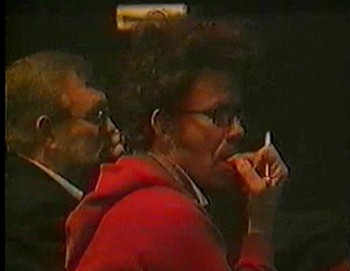
Waits during Alice rehearsals. Thalia Theatre. December 1992(11)
Paul Gorman (1999): "Alone, Waits decamped to a small hotel amid Hamburg's filthy strasses to work on the orchestration for a six-week stint, toiling against the clock to make the pre-Christmas opening night and, by all accounts, pining for Californian family life. "It was a pretty fraught time for Tom," recalls Mark Cooper, who directed a short documentary on the production for BBC's Late Show. "When we arrived he was involved in all the fine-tuning and the sheer stress was obviously getting to him. We set up all this gear and lit a piano in the centre of a room, which maybe looked too glamorous. He threw a complete paddy and demanded we shoot him at a broken down, out-of-tune upright piano in the corner of the room. He insisted that we just use the sound from the camera and a single light. Of course he was right--it worked brilliantly. Footage reveals "Alice" to be far more accessible than the harsh and brittle "The Black Rider", with a collection of superb songs exquisitely performed by the Thalia players. "'Alice' was magnificent," summarises Cooper. "It had brilliant music and fantastic ballads presented beautifully by Wilson."(4)
Tom Waits (1992): "Wilson's things come out of his head. Everyone moves like Wilson moves. He really unscrews the top of his head and takes all the characters out of it, winds 'em up. Everything on stage comes out of his head. If there's a tree, he sketched it first, and then had it blown up and drawn exactly the way he sketched it. It's like you walk into a house and everything was made the guy who designed it. There's nothing in it that came from a store - nothing. The paint, lampshades, doorknobs, everything. And you go into it and feel a little strange. You know - That's a bird bone chair, Bob. I don't know if I should sit there... They become meditations. Time moves much slower in his pieces. Everything appears to be moving in slow motion, but really it's just giving you longer to register the theatrical information, so that you can really be inside the theater and experience it. If you don't change time in some way, it's not theater. It's real. So I find it riveting, really, to work with somebody with such a...spell. Hardest part is you want to introduce the right things to that spell, and that's what becomes the riddle. You don't want to be the garlic in the cinnamon cake. Yet a little garlic in cinnamon cake might be in order here..."(9)
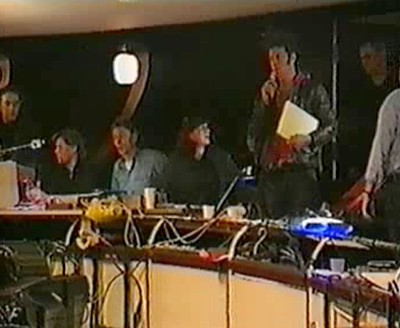
Waits during Alice rehearsals. Thalia Theatre. December 1992(11)
"Alice" is second in a Wilson-trilogy that began with The Black Rider (1990) and ends with Time Rocker (1996). The principal characters are Alice (who is both the fictional character and her real-life model, Alice Liddell) and the author, Charles L. Dodgson, both of whom appear in various guises throughout the production. The songs by Tom Waits were presented as intersections with the text, rather than as expansions of the story. The 3-hour play premiered on December 19, 1992 at the Thalia Theater, Hamburg/ Germany:
Stagings (Wilson productions):
Thalia Theater, Hamburg/ Germany: Dec. 19, 1992 - Jan. 1993
Theater am Pfalzbau, Ludwigshaven/ Germany: Feb. 7-11, 1993
Centro Cultural de Bel�m, Lisbon/ Portugal: Mar. 12-14, 1994
Teatro Vittorio Emmanuele, Massina/ Italy: June 4-6, 1994
Brooklyn Academy of Music, New York City/ USA: Oct. 6-8, 10-14, 1995 (1)
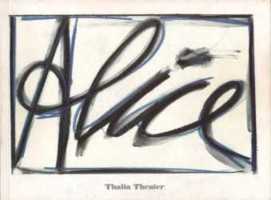
Front cover of the Thalia Theater program(3)
Somehow "Alice" didn't get as much (media) attention as "The Black Rider" did. Maybe because of its simple plot, or maybe it didn't appeal to the German audience (as opposed to The Black Rider with its roots in German literature). Untill 2002 Waits had never released anything from the "Alice" works and there were only few recorded (live) performances known, so for years the play remained kind of a mystery, only attended by a happy few. In 1999 a bootleg surfaced in Holland (Kees Lau), called "Alice, The Original Demos". The origins of these studio recordings (which were never meant to be released) are unknown, but it is said the tapes might have been stolen from Waits's car late 1992.
Tom Waits: "When we were doing the songs, all the tapes were in my briefcase. My car was broken into and someone stole the work tapes of the show. They realized they had something that might be worth some dough so they ransomed it, and I paid $3,000 to get it back. Not a lot of money, was it? I was a little insulted."... "I think they wanted fast cash and no arguments. Along the line, the tapes got copied and the bootleg got out. At the time, I wasn't interested in recording anything at all. I was taking a break from the whole damn business, so it went south. The songs sat in a box, and I thought they were worth looking at again."(6)
Tom Waits: "Those Alice songs were all in a briefcase that got stolen out of the back of my car, and they were ransomed by these radicals who thought they really had something. We had to pay a couple grand to get the briefcase back, but I think they copied the tapes."
O: What was the exchange like? Did you get to meet them somewhere?
Tom Waits: "Yeah, some dark caf�, you know, everybody was wearing sunglasses, it was really cold. They said, "We're gonna leave the briefcase by the trash can. Put the money in a bag..." It added a little intrigue to the whole project."(8)
On the CD it says this recording is released by EMI Holland, but of course there's no such thing. A couple of months later a second bootleg CD was released by PmS Canada, simply called "Alice" (this CD has 2 extra tracks, taken from the WDR TV documentary "Vision's d'Alice", 1993). Neither of these CD's are authorized by Tom Waits.
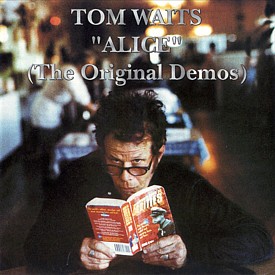

Covers for "Alice EMI, Holland" and "Alice PmS, Canada"
Tracklisting for "Alice, The Original Demos"
Printed in Holland, 1999: EMI 0 7777 89265 2 8.
1. There's Only Alice (4:04). Sung by the White Rabbit in scene 1
2. No One Knows I'm Gone (2:02). Sung by Alice in scene 1
3. Tabletop Joe (3:15). Sung by the Caterpillar in scene 2
4. Komme Nie Zu Sp�t (3:03) Played in scene 3
5. Hang Me In The Bottle (2:36). Sung by March Hare, Mad Hatter and Dormouse in scene 5
6. Down The Reeperbahn (2:57). Extra song added to scene 7
7. One, Two, And Through (3:31). Sung by Chorus Of Vicars in scene 8
8. Everything You Can Think Of Is True (2:57). Sung by the White Knight in knee 9
9. But There's Never A Rose (3:44). Sung by Humpty Dumpty in scene 10
10. What Became Of Old Father Craft (6:04). Sung by Duchess and Mad Hatter in knee 7
11. Chained Together For Life (3:30). Sung by the White Knight in knee 14
12. Falling Down The Lane (1:36)
13. Untitled instrumental track. Early version of "Barcarolle" (4.06)
14. Untitled instrumental track. Early version of "Fish And Bird" (2.34)
15. Untitled instrumental track (3.22)
16. Untitled instrumental track (3.28)
17. Untitled instrumental track (2.25)
18. Untitled instrumental track (4.41)
19. Untitled instrumental track (3.18)
20. Untitled instrumental track (1.37)
21. Untitled instrumental track. Early version of "No One Knows I'm Gone" (2.20)
22. Untitled instrumental track (2.55)
23. Untitled instrumental track (4.12)
<object classid="CLSID:22d6f312-b0f6-11d0-94ab-0080c74c7e95" codebase="http://activex.microsoft.com/activex/controls/mplayer/en/nsmp2inf.cab#%20Version=5,1,52,701" height="46" id="MediaPlayer1" standby="Loading Microsoft Windows� Media Player components..." type="application/x-oleobject" width="320"><embed autostart="0" height="46" name="MediaPlayer1" pluginspage="http://www.microsoft.com/Windows/MediaPlayer/" showcontrols="1" src="http://www.tomwaitslibrary.info/audio/alice-playlist.m3u" type="application/x-mplayer2" volume="-300" width="320"></embed> </object>
Listen to audio excerpts of the untitled instrumental tracks
Taken from "Alice, The Original Demos".
Printed in Holland, 1999: EMI 0 7777 89265 2 8.
(click "next" to switch tracks)
The Alice bootleg tape gives an interesting insight into how Waits composes his songs, for most tracks are rough instrumentals with no lyrics added yet. One should keep in mind that 1992 is the year when both "Night On Earth" and "Bone Machine" were released. The music for "Alice" has, as a matter of fact, a lot in common with "Night On Earth" and to a much lesser extent with "Bone Machine". Untill 2002 Waits had never released anything from the "Alice" works. This was very remarkable, for the earlier plays: "Frank's Wild Years" and "The Black Rider" both turned into very successful studio albums. Maybe it had to do with the alleged theft of the original tapes. It is rumoured the Thalia Theater might have bought back the stolen tapes on account they would be granted all copyrights. But, that's rumours...
Paul Gorman puts it like this: "So why didn't Waits release any of the songs? Firstly, they are owned by the Thalia Theatre and "Alice" has now entered the state-backed troupe's repertory. It's also likely that Waits was put off exploring the musical in the recording studio because of the unhappy associations created by the hectic production schedule."(4)
Q: I've read that the Thalia theatre actually owned them for a while is that not true?
Tom Waits: "The songs? I don't think so."
Q: So that even if you had wanted to record around the time you wouldn't have been able to because they were in the theatre's repertoire.
Tom Waits: "Oh, I wasn't aware of that. It didn't really matter really. Because I wasn't thinking of recording them until really recently, long after the show itself had its cycle. It's run."(7)
Tom Waits: "The songs were written around '92 or '93, 'round in there. It was done with Robert Wilson in Germany. We stuck 'em in a box and just left 'em there for a while. They were aging like the honey. And we locked in the freshness. They were hermetically sealed. You move on to other things, you know? And then you go back and say, "Well, this was okay."
O: It was kind of developing a reputation as the great lost Tom Waits album.
Tom Waits: "I bought a copy of the bootleg on eBay. 'Cause I didn't know where those tapes were."
O: How does the bootleg hold up?
Tom Waits: "Okay. There was stuff that didn't make it on to the record."(8)
Robert Wilson (1992): "I have never before created a play with fourteen scenes. In Alice I had two acts based on the two Alice books with seven scenes and seven knee plays each. The first act is set in a room, an interior man-made space, with natural objects. The second act is set in a forest, an exterior natural space, with man-made objects. The whole play is framed by Charles Dodgson alias Lewis Carroll, the mathematician, author and photographer who liked to photograph little girls. One of them was Alice Liddell, for whom he invented the story of Alice in Wonderland. Dodgson alias the White Rabbit alias the White Knight guides Alice through the play. It starts with Knee Play 1 showing how Dodgson attempts to photograph Alice, and how fleeing from him she falls into Wonderland. The middle scene of each act functions as a supportive column, which brings in the autobiographical perspective, and has a very colorful set. Scene four shows Alice Liddell, now grown up, alone, drinking. Scene eleven shows Charles Dodgson alone, sleepless. The finale of each act (scenes seven and fourteen) is a trial scene, in which first Alice, then Dodgson are found guilty of this relationship."(2)
Paul Schmidt (1992/ 1993): "One of the things that we started with, was the notion of Dodgson as a photographer. We know he took pictures of little girls, that's what he liked to do. And when you think of the image of what a camera was in those days. Those enormous boxes with the long snouts sticking out in front of them, the lens and the great black cloth from the photographers head. And the braces that people had to sit in, to hold the pose. It must have been a terrifying experience. It might have been a terrifying experience for a young child."(10)
|
|
|
|---|---|
|
Alice Pleasance Liddell, 1859 |
Alice Pleasance Liddell: "Gypsy girl", 1859 |
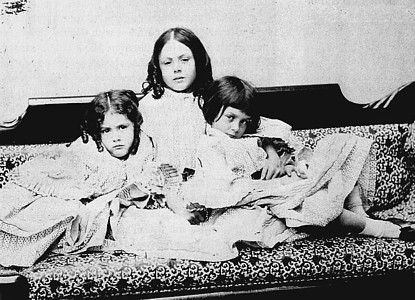
Edith, Lorina and Alice Liddell
Robert Wilson (19992/ 1993): "There are various levels of the narrative. There's the text by Paul Schmidt, which is one thing, and you have the lyrics of Tom which are another. And they're sort of counterpoints and sometimes it's like a grid or something, that can be lined out so that the visual imagery or this visual story is lined up with Paul's text and Tom's music. And sometimes they're like grids that are going out of phase, and sometimes they line up. But often they're sort of counterpoints to one another."(10)
Paul Schmidt (1992/ 1993): "A lot of fun fairs that I know of in America are called Wonderland. You get that all the time. It seemed to me it was kind of a natural connection. And the other interesting thing that Tom really found, was sort of the underside of Victorian life, I mean we think of proper Victorian England, but you look at some of the freak shows and things that grew up in the nineteenth century, it was sort of a darker underside of it. And that's where a lot of Tom's images plug in beautifully. I think they really reflect terrifically, there was a tension between some of those images and the surface innocence of the Alice story."(10)
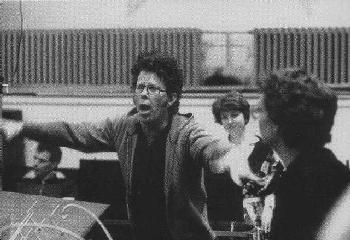
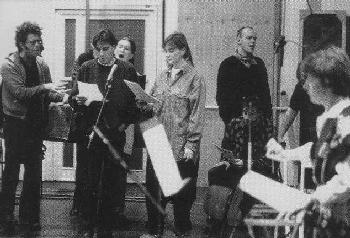
Alice rehearsals at the Thalia Theatre, 1992. Photography by Thomas Wollenberger
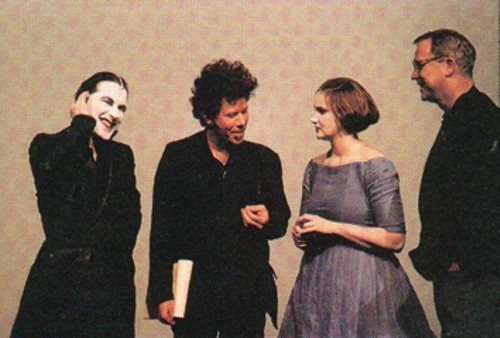
Stefan Kurt, Waits, Annette Paulmann and Robert Wilson (MOJO magazine, april 1999).
Waits released a studio album (Epitaph/ ANTI) with the songs from Alice, on May 7, 2002.
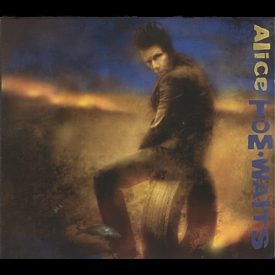
Tracklist:
1. Alice (4.28) Sung by the White Rabbit in scene 1
2. Everything You Can Think (3.10) Sung by the White Knight in knee 9
3. Flower's Grave (3.28) Sung by the Rose in knee 2
4. No One Knows I'm Gone (1.42) Sung by Alice in scene 1
5. Kommienezuspadt (3.10) Played in scene 3
6. Poor Edward (3.42) Aka. Chained Together For Life. Sung by the White Knight in knee 14
7. Table Top Joe (4.14) Sung by the Caterpillar in scene 2
8. Lost In The Harbour (3.45) Aka. But There's Never A Rose. Sung by Humpty Dumpty in scene 10
9. We're All Mad Here (2.31) Aka. Hang Me In The Bottle. Sung by March Hare, Mad Hatter and Dormouse in scene 5
10. Watch Her Disappear (2.33) Sung by Charles Dodgson in knee 4
11. Reeperbahn (4.02) Extra song added to scene 7
12. I'm Still Here (1.49) Sung by Alice at the end of the play scene 14
13. Fish And Bird (3.59) Aka. untitled instrumental piece # 14 from the Alice demos. Sung by The White Knight in scene 7
14. Barcarolle (3.59) Aka. untitled instrumental piece # 13 from the Alice demos. Sung by White Sheep and Alice in knee 10
15. Fawn (1.43) Instrumental piece, probably written for scene 6 "The Wood Without Names"
Notes:
(1) From Robert Wilson site at: http://www.robertwilson.com/works/masterAlice.htm
(2) Source: "Let the piece talk to you." Jan Linders. Theatre/Public 106, June-July 1992. As published on the Robert Wilson site at: http://www.robertwilson.com/works/masterAlice.htm
(3) Program book published by: Thalia Theater GmbH, Alsertor, 2000 Hamburg 1/ Germany. Direction: J�rgen Flimm, Ludwig von Otting, Heinz-Werner K�ster. Editors: Niklaus Helbling, Wolfgang Wiens.
(4) Source: "Tom's Lost Classic". MOJO magazine, Paul Gorman. Sept./ Oct. 1999
(5) From ANTI records site (April, 2002) at http://www.anti.com/
(6) Source: "This Business Called Show " Austin Chronicle (USA) May 10, 2002 by Margaret Moser.
(7) Source: "Never one for the conventional" Inpress Magazine (Melbourne, Australia) by James Nicholas Joyce. May 1, 2002.
(8) Source: "Tom Waits" The Onion A.V. Club online magazine (USA), by Keith Phipps. Volume 38, issue 20. � Copyright 2002 Onion, Inc., All rights reserved. Date: Telephone interview. Published: May 29, 2002
(9) Source: "Waits In Wonderland" Image magazine (USA), by Rip Rense. Date: December 13, 1992
(10) Source: "Tom Waits & Robert Wilson's Alice", The Late Show. BBC TV documentary. Date: aired March 4, 1993
(11) Source: "Visions D'Alice" French/ German documentary by Thierry Thomas for La SEPT/ ARTE.. Date: December, 1992
Special thanks to Hans Nijs for sharing the "Alice" theatre program.


